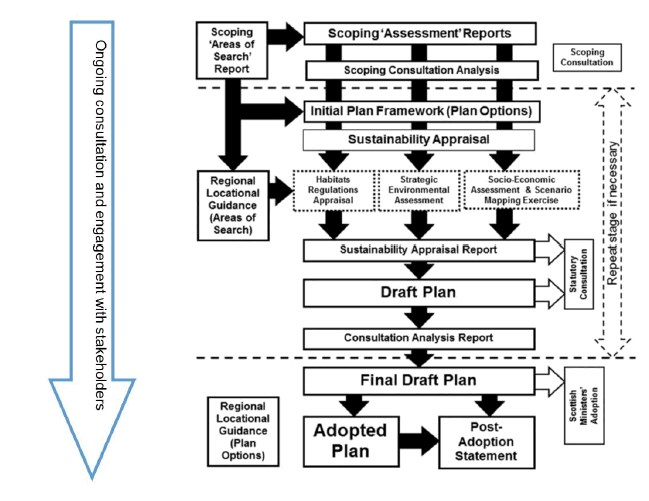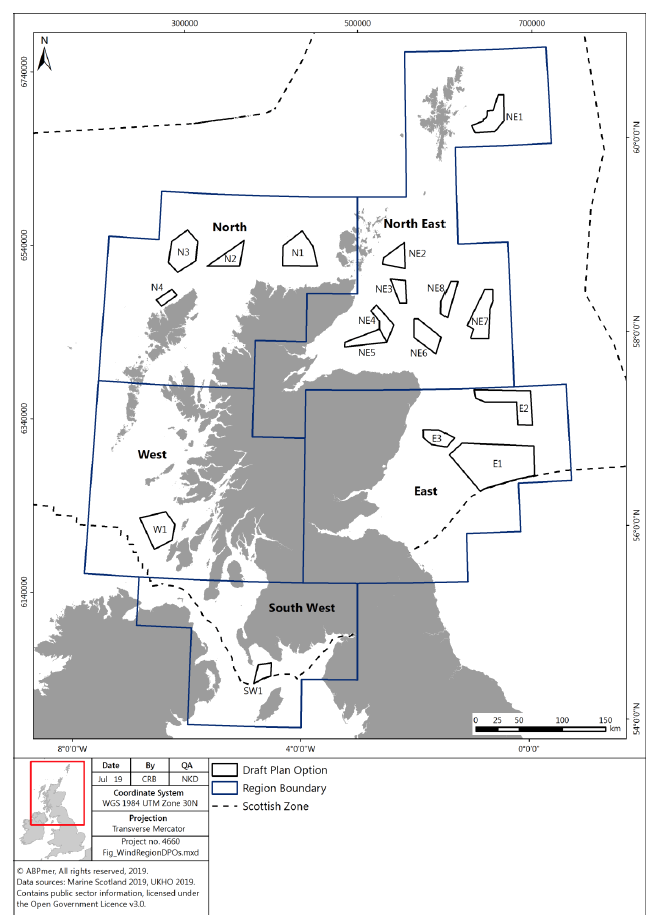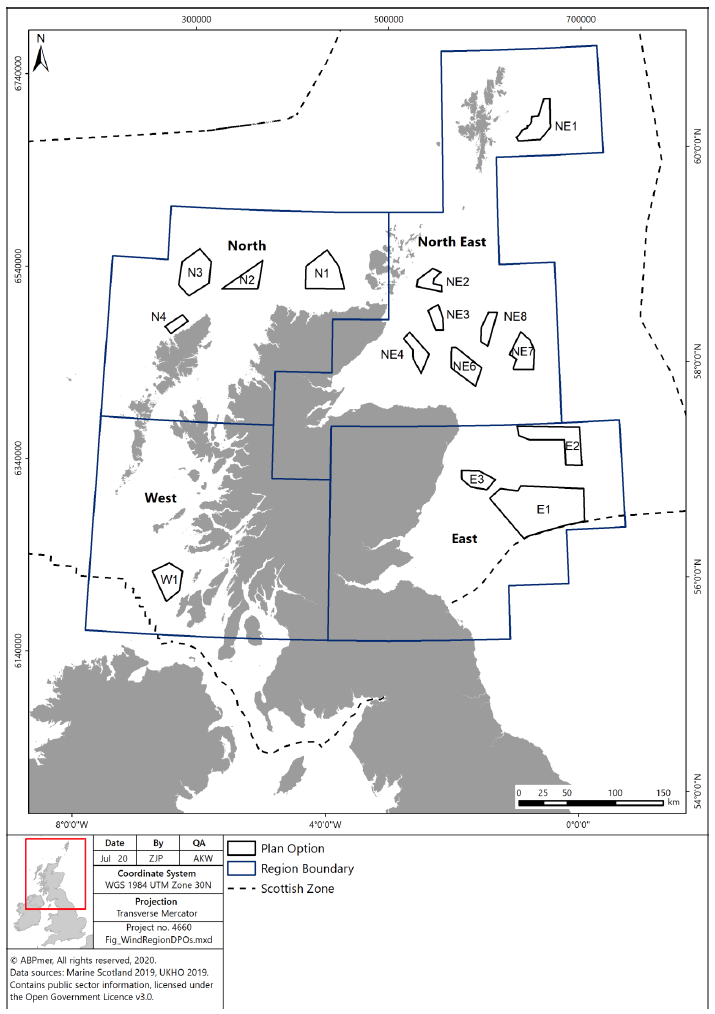Sectoral marine plan: post adoption statement
Sets out the changes between the draft and final sectoral marine plan for offshore wind energy in accordance with Section 18(3) of the Environmental Assessment (Scotland) Act 2005 (“the 2005 Act”).
1 Introduction
1.1 Background
1.1.1 The Scottish Government is committed to ensuring secure, reliable and affordable energy supplies, within the context of long-term decarbonisation of energy generation. The continued growth of the renewable energy sector in Scotland is an essential feature of the future clean energy system and a potential key driver of economic growth. As a nation with an abundance of renewable energy resources, opportunities exist not only to meet domestic needs, but also to export low carbon energy to the rest of UK and Europe.
1.1.2 To date, Scotland has seen a significant amount of offshore wind energy activity, with 14 offshore wind farms (including two floating wind farms) having received consent, six of which are currently operational, equating to a total generating capacity of just over 5 Gigawatts (GW). Our first Sectoral Marine Plan for Offshore Wind Energy (Blue Seas Green Energy) ("the 2011 Plan") was adopted in 2011[1], with draft wind, wave and tidal plans subsequently produced in 2013[2].
1.1.3 Recent technological, policy, regulatory and market developments, such as the commitments outlined in the UK Offshore Wind Sector Deal[3], the development of new technologies suitable for deployment in deeper water and the aspirations established in recent climate change legislation have presented the opportunity for Scottish Ministers' to undertake a new strategic planning process.
1.1.4 In November 2017, Crown Estate Scotland (Interim Management) ("(CES)(IM)") announced its intention to run a further seabed leasing round for commercial scale offshore wind energy projects in Scottish Waters. To inform the spatial development of this leasing round, Marine Scotland, as planning authority for Scotland's seas, is required to undertake a planning exercise in accordance with relevant UK, European Union (EU) and Scottish legislation. This planning process will ensure that the spatial strategy is in place to support the forthcoming Crown Estate Scotland (CES) 'ScotWind' leasing round and enable the continued successful development of commercial-scale offshore wind. The planning process for the draft Sectoral Marine Plan for Offshore Wind Energy ("the Draft Plan") commenced in early 2018, following the process outlined in Figure 1, and builds upon the previous planning exercises (undertaken in 2011 and 2013).
1.1.5 During the early development of the Plan, there were a number of steps in the identification of potential areas for future offshore wind development. Initially the Constraints analysis and scoping identified a series of Areas of Search (AoS), which formed part of early consultations. These were then developed as an iterative process alongside early assessments and consultation to the Draft Plan Option (DPO) areas which were the basis for formal assessment.
1.1.6 The assessments were subsequently undertaken, based on the Draft Plan Option areas shown in Figure 2 and reports produced to summarise these. Consultation on the Draft Plan and the assessment documents (Strategic Environmental Assessment (SEA), Socio- Economic Impact Assessment (SEIA), Habitats Regulations Assessment (HRA), Equalities Impact Assessment (EQIA) and Island Communities Impact Assessment (ICIA)[4]) took place between December 2019 to March 2020 and the outputs of this consultation exercise are outlined in the consultation report[5].
1.1.7 Following review of the outputs of the assessments, consideration of comments received during the consultation, and as a result of further consultation amendments were made to the DPOs in order to develop the Plan Options included within the final Plan (Figure 3). In order to ensure the validity of the assessments undertake in the light of these final Plan Options, a review of the changes, in addition to any further data which has been identified or released during or following the consultation, has been undertaken against each of the key assessments, see Annexes A (SEA), B (SEIA) and C (HRA) for the outcomes of the review (the impacts of changes on the EQIA and ICIA were reviewed and deemed not to require detailed assessment).
1.1.8 The final Plan provides the spatial framework for the first cycle of seabed leasing by Crown Estate Scotland ("CES"), which launched in June 2020[6].

1.2 The use of scenarios during the assessment process
1.2.1 Scenarios were developed relating to the potential scale of development within each option area, taking account of the ambitions of the plan (maximum of 10 GW installed capacity) in order to feed into assessment processes so that the outcomes of assessments were realistic. These scenarios were used in both the SEA and the SEIA and ultimately allowed for some consideration of spatial planning within each plan option area as a mitigation measure. Whilst these scenarios gave an indication of the potential scale of maximum development consistent with the aspirations of the plan they should not be taken as being an endorsement of projects up to this size within an option area, as further project level assessment and planning will be required to ensure avoidance of significant adverse effects. Consideration of the potential constraints associated with environmental, social and economic effects of developments is provided within the SEA, SEIA, HRA and RLG reports.
1.3 Structure of this Post Adoption Statement
1.3.1 Section 18(3) of the Environmental Assessment (Scotland) Act 2005 ("the 2005 Act") sets out the information which should be included in the SEA Post Adoption Statement. In summary, it should include;
- How the environmental considerations have been integrated into the plan, programme or strategy;
- How the Environmental Report has been taken into account;
- How the opinions expressed by consultees have been taken into account;
- The reasons for choosing the plan, programme or strategy as adopted, in light of other reasonable alternatives considered; and
- The measures to be taken to monitor the significant environmental effects of the implementation of the plan, programme or strategy.
1.3.2 In addition, this Post Adoption Statement incorporates other elements of the process leading to the development of the adopted Plan including:
- How the SEIA process has been taken into account; and
- How the HRA process has been taken into account


Contact
There is a problem
Thanks for your feedback